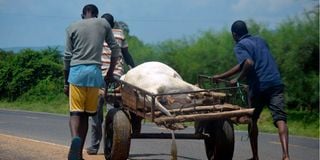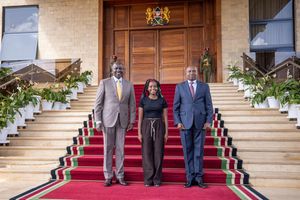Premium
This is how to catch quack vets risking your animal’s life

Men ferry a sick cow to a local veterinary clinic on the Katito-Kendubay road in Nyakach, Kisumu County, in June 2019. Farmers have been advised to ensure that their animal health service providers are licensed by the KVB.
During my many years of veterinary practice, I have come across numerous fake animal health service providers. The most dramatic one was when I found a fellow trying to carry out a caesarian section on a cow to extract a calf from the uterus.
The operation is a major surgery; yet the fellow was carrying it out with reckless abandon. The farmer had called me because he was worried the operation was going wrong.
The fake service provider went by the name Dr Rajwai and was popular with farmers in the area before I set up office there. I had started suspecting he was a fake because farmers often described his unorthodox and absurd treatments with an outcome mix of high death rates of the treated animals.
Impeding death
On the day I encountered him, the farmer had called me saying the “doctor’ had started operating on his cow but the animal was bleeding too much. It also appeared to be in pain. By the time I arrived, he was removing the calf from the uterus but the cow had already gone down and lay on its side. That is usually a sign of impeding death in cattle. The normal position is to lie on the breast.
The “doctor” greeted me animatedly and asked me to take over the case because it was proving difficult. I did not recognise him. The year he gave me of his graduation from the University of Nairobi betrayed him because I knew all the graduates of that year since they were just one year ahead of me and we had had lots of interactions in senior students affairs.
The farmer introduced the fake as Dr Rajwai. I was happy to meet the legendary “vet” whose majority of patients never recovered. It was evident to me even the current patient was going to just enhance his fatality count.
I declined the invitation to take over and told him to complete since he had already done the major work. However, for the sake of the animal, I advised him to add more local anaesthetic or pain medicine to reduce the cow’s suffering and bleeding.
I confirmed his quackery when he appeared not to understand the behaviour of the emptied uterus. The organ quickly appeared to be running back into the abdominal cavity. He asked himself why the uterus was running back so fast.
Involution
The reaction of the uterus is called involution and happens very rapidly after the organ’s pregnancy contents are emptied.
You see, the uterus is an amazing organ. One can hold a normal non-pregnant uterus of a cow in the fist. But when pregnant, the organ increases its size to hold a 40kg calf and about 20 litres of fluid when ready to calve down.
Immediately after the uterus is emptied of its pregnancy contents by calving or surgical extraction, the organ visibly contracts to a small fraction of its pregnant size.
A surgeon is supposed to hold the uterus outside the body and stitch the surgical wound very quickly after extracting the pregnancy contents to prevent the organ from disappearing into the abdominal cavity while open.
Dr Rajwai was not privy to the contracting behaviour of the cow uterus. He let it disappear with the big surgical wound still open and pretended all was fine.
He stitched up the body wall in a single layer plus the skin. I could only pity the cow, which was almost dead by then.
I sympathised with the farmer and the cow but at times, when the situation is already hopeless, it is better to collect evidence of fraud rather than to scare the fraudster.
Once the cow’s mutilation was complete, I excused myself and whispered to the farmer that he should soon call me back to carry out post-mortem examination to enable us to file a fraudulence report with the Kenya Veterinary Board (KVB).
The poor cow surely died and the post-mortem revealed the open uterus that had caused massive infection and inflammatory reaction in the abdominal cavity. I reported to the KVB and it caught up with the fake doctor and prosecuted him.
It is surprising that such cases of quacks are still rampant even today when the KVB has implemented an elaborate system of registering and licensing veterinary doctors and veterinary paraprofessionals.
These cadres of animal health practitioners are jointly called animal health service providers. They are akin to the doctors, nurses and clinical medics in human health.
Veterinary doctor
Each animal health service provider is registered and licensed by the KVB and given a unique identification number. They are also retained annually in the national register of service providers by the Board.
This week there was a heated discussion in a big farmers’ digital forum. The majority wondered how they could be protected from quack animal health service providers.
One farmer narrated how a farmer in his area lost all her dairy investment when her premium dairy cows died. The insurance company covering the animals realised that the health certificates of the animals issued for insurance had been prepared by a fake veterinary doctor.
I advise all farmers and animal owners to ensure that their animal health service providers are licensed by the KVB and properly retained in the register for the year. A service provider should always write down their KVB number when they offer services.
A veterinary surgeon is a university graduate of veterinary medicine who has studied the discipline at university for five years. A paravet studies animal health and production at a KVB accredited college for a two-year certificate, three-year diploma or a four-year university training in animal health and production. All cadres complete a one-year supervised internship programme before registration and licensing by the KVB.





